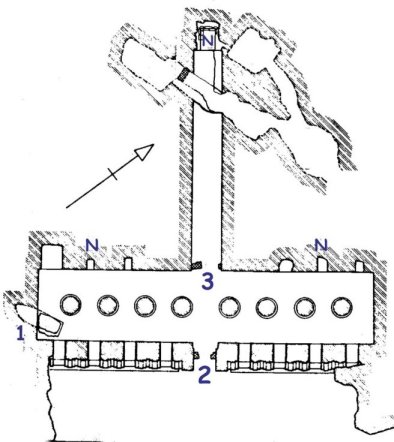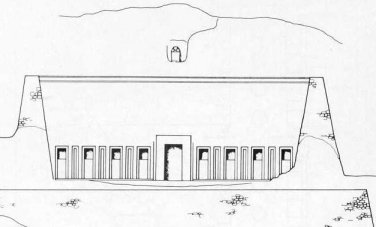 |
Senenmut |
last update:
05.02.2010
|
| |
TT71
|
|
|
The monument of the Senenmut on the hill "Sheikh Abd el-Qurna" was opened 1930 by
H. E. Winlock. However, already 100 years earlier the tomb was - despite
the devastated condition of its walls - the target of numerous "investigations". |
|
Wilkinson (1827 - 33), Hay (1824 - 38) and Wild (1842 - 48) copied remainders of the wall decorations, however,
nobody left complete reports about the tomb. |
|
The Prussian expedition headed by Lepsius (1842 - 45) also copied several
stamped bricks and the inscriptions of the small steles carved into the
walls of the axial corridor. In addition, the group carried off to Berlin the false-door
stele (today in the Egyptian
Museum in the Bode-Museum, Berlin; see below) that
had played a central role in the funerary cult. |
|
The surprising discovery of his second tomb, TT353, by Winlock in 1927 threw new light on
TT71, but
delayed by projects with greater priority (the excavation of TT353) Winlock could not turn
back again to TT71 before the season of 1930 - 31.
|
|
The discussion about the "Dating
of TT71" is presented on a separate page.
|
| left the floor plan of TT71 (N= Niches; 1= shaft, 2,
3= bricked door jambs), right a reconstruction of the frontal view (above
the entrance of the niche cut into the rock with the unfinished block
statue of Senenmut and Neferu-Ra; see below); after Dorman, 1991 |
| TT71 was cut T-shaped into the rock (see floor
plan). In front of it was a forecourt (approx. 40 m broad and 25 m
deep). To overcome the steepness of the hill an artificial terrace was
built across the forecourt. A ramp connected the two parts of the
forecourt. The frontal view of
TT71
might have resembled therefore - in
a smaller form - Djeser djeseru.
|
| The tomb of his parents, consisting of
one room only, was discovered
under the forecourt by A. Lansing and W. Hayes in 1936. The location of the
tomb of his parents directly below the court of TT71 was most likely
intended - probably as a joint burial to honor his parents. |
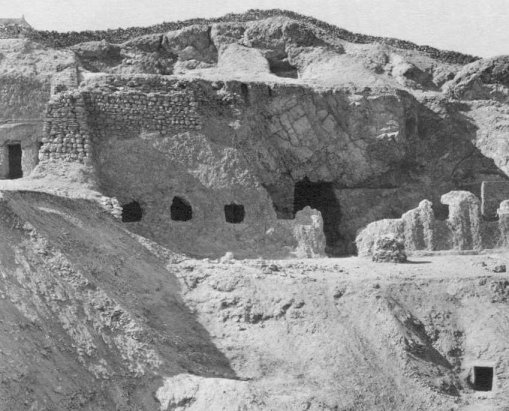 |
|
above the front view of TT71 shortly after the tomb of his
parents (the entrance is shown in the lower right corner of the picture)
has been discovered (photo Dorman, 1991); above the central entrance
to TT71 there is the passage with the rock-cut block statue of Senenmut with Neferu-Ra
(see below)
|
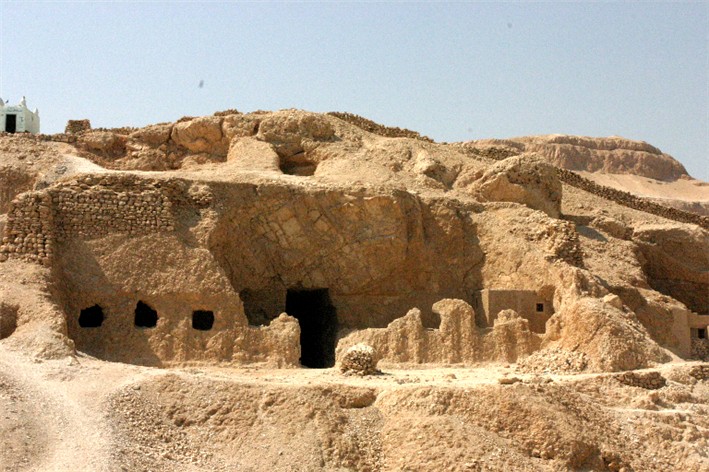 |
|
left a photo from the front view as it looks
today (March 2007), taken from a similar position like the left
picture;
above the tomb, left on the top of the hill the small chapel of "Scheikh
Abd el-Qurna"
|
| The facade of TT71 was carved directly from the rock -
only a few minor plaster patches were used to fill small fissures. The
central doorway opens into a transverse hall approx. 26 m long which is
divided by a central row of eight columns (see photo below) into two aisles. The central
doorway of the facade is flanked at each side by four square windows which allow light
to enter the transverse hall. The bases for the windows were cut directly from the rock, the lower edge of the windows were
about 2.1 m above the bottom. In the height of the lower edge of the
windows the facade was still approx. 1.5 m thick. At both sides, between each
window niches enliven the battered facade.
The pattern of niches is still visible today (see photos above). |
| The top of the facade is destroyed (see left photo above) and could be
reconstructed only due to archaeological investigations.
|
| The central row of eight 16-sided columns with a diameter of approximately
1.4 m were also cut directly from the rock and divide the transverse hall
into 2 aisles (an eastern and a western aisle). These aisles were approx. 4.2 to 4.5 m high and all had
a differently shaped ceiling. The width of the hall was approx. 5.2 m.
|
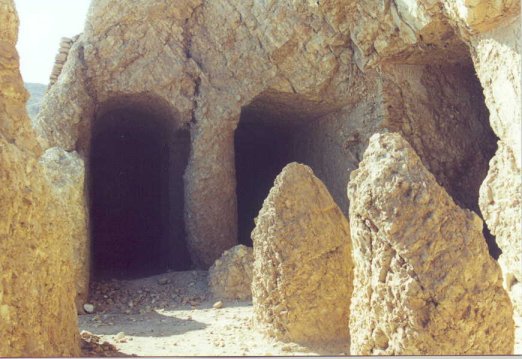
| Above the southern part of the pillared hall
of TT71, right hand, the entrance to the central corridor. |
| On the rear wall of the pillared hall several niches of
different size were hewn (see floor plan above, position N) into the rock in such a way
above that they were illuminated in the morning from the opposite windows.
Nothing is known about the function of these niches, but it was assumed that everyone should take up a statue of
Senenmut. However, this is not testified at all because there is only one block statue (Egyptian
Museum in the Bode-Museum, Berlin) which ever had been connected to TT71
- however, this connection is doubtful.
|
| In the southeast corner of the pillared hall (see floor plan, left
corner) a shaft was discovered, which opens after 1.9 m into a small chamber (3,5 x 1 x 1,05 m).
Most likely, this chamber should take up the sarcophagus with Senenmut's mummy. This part of the
monument was almost finished, when the work on it was stopped.
|
| In the center of the rear wall of the pillared hall a narrow
corridor goes 23 m deep into the rock. The far end of the corridor was
the funeral focus of the tomb. The lower part of the wall was lined with red
quartzite false-door (shown below) which was discovered in situ by
Lepsius and removed to Berlin in 1845. Above this false-door stele,
approx. 2.6 m over the floor another niche was craved out of the rock (1.15 x
1.3 x 1.74 m). The walls of the nice were covered with limestone forming
a small shrine (some the limestone blocks are still located in their
original position). Most likely, the niche should accommodate a block statue of the Senenmut
- perhaps that one that is shown in Berlin (see below).
|
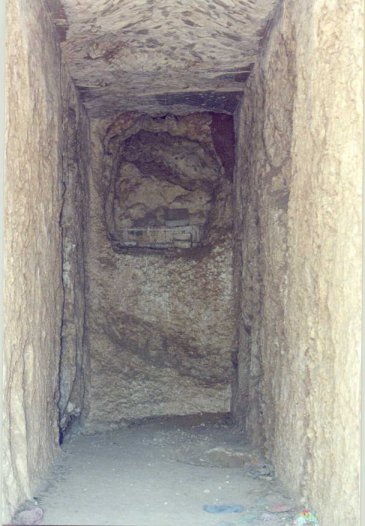
| Above: TT71, corridor with niche; at the end of the
corridor remainders of the painting can be detected at the ceiling. Probably,
the false-door stele and the block statue of the Senenmut with princess Neferu
Neferu-Ra (Museum Berlin, objects Nos 2066 and 2096) had their original position under or in the
niche, resp.. Below, a picture of the block statue of the Senenmut with
Neferu-Ra (foto taken by M. Stuhr). This statue was purchased 1843 by Lepsius from
a private collection, unfortunately, the site of the discovery and i.e.
the original place were the statue had been erected is not documented. |
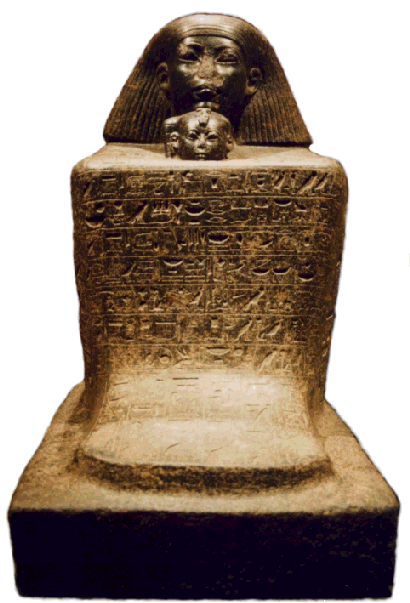
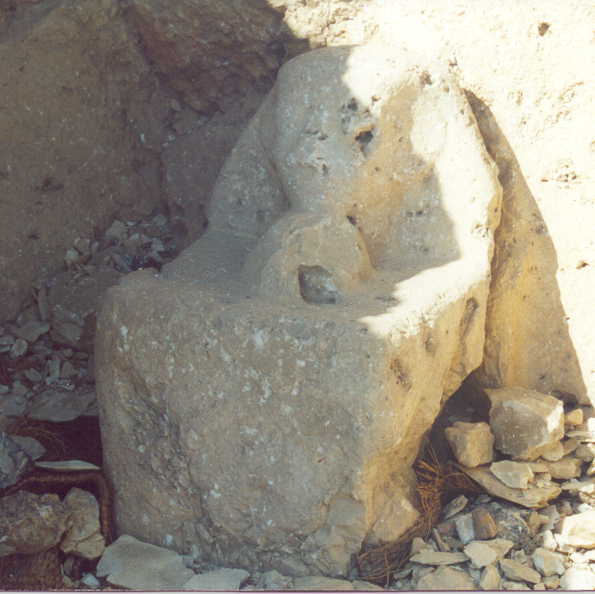
Above the unfinished block statue of Senenmut with princess Neferu-Ra in the rock-cut
shrine above
tomb TT71 (photo taken December 2001). Over thousands of years the originally
corridor was completely destroyed. |
Above
TT71
a special architectural
supplement can be visited.
Exactly over the corridor of
TT71
and at height of the upper edge of the horizontal front
of the facade a corridor was cut 7 m long and 2 m a broad into the rock.
At its western end, in a flat recess, a block statue was hewn directly
from of the rock. Like the corridor the uninscribed block statue had not
been finished.
The roughly formed statue resembles well-known representations of Senenmut and
Neferu-Ra. Therefore, it is obvious that Senenmut and Neferu-Ra,
who is covered by Senenmut's cloak, are also represented here.
|
| There are, however only few monuments that show a comparable supplement. Senenmut's contemporary, Senimen - who for some time was regarded to be
a brother of Senenmut - has erected a comparable statue above his tomb, TT252, which shows him with Neferu-Ra on his lap and together with his
mother, Seniemyah, standing beside him. |
| The greater part of the transverse hall is destroyed, only at
the southern end the ceiling and a few supporting columns have been preserved.
The ceiling of the northern wing is completely collapsed. . |
| The walls and the ceiling of TT71
were completely decorated with
colored scenes which had been finished without those in the chapel. Today,
from the original colored decoration of the walls and the ceiling only
few remainders have survived, so among others 9 smoothed wall parts,
each formed like a stele and containing inscriptions. All inscriptions
show signs of intentional destruction. |
| These 9 wall-steles belong the rather unusual decoration elements
seen in TT71. Therefore, they are arranged and described in detail on their own page
- TT71 - Wall-stelae.
|
| The remaining decoration of the
Corridor as well as the remaining
decoration of the Transverse Hall are
presented on own pages. |
|
On the ceiling of the transverse hall the names of his parents,
Ra-ms
and @At-nfrt,
who were called zAb
(Honorable, Senior) and nbt-pr (Lady of the
House), as well as the only preserved name of the Senenmut had been
found, together with a curse of the Senenmut against all who cause damage to
his tomb:
"Concerning any man, who will cause damage to my statue,
he may not follow the king of his time;
he may not be buried in the western cemetery;
he may not be given any lifetime on earth."
(see Meyer, 1982)
The curse was obviously not of great power, because a large part of the decoration
has been destroyed clearly with intention. Most likely, the Amarna
period was responsible for destroying the names of the Gods. However, for the destruction of
his pictures and names both, Hatshepsut and Thutmosis III. may have been
responsible. Frequently, it is assumed that Senenmut has fallen into disgrace (see also
"Career and Fall
(?)"- if so than Hatshepsut is the first candidate who may have
given the order to damage his monuments.
The inscriptions in TT71
give, like his statues, a strong reference to
his relation to Hatshepsut or to his outstanding position at the court -
probably promoted by her. Inside TT71
there are no references to
Neferu-Ra, only the rock statue above TT71
(and some funeral cones) gave a reference to the princess and probably suggest that
she was still alive when the construction of the monument commenced.
|
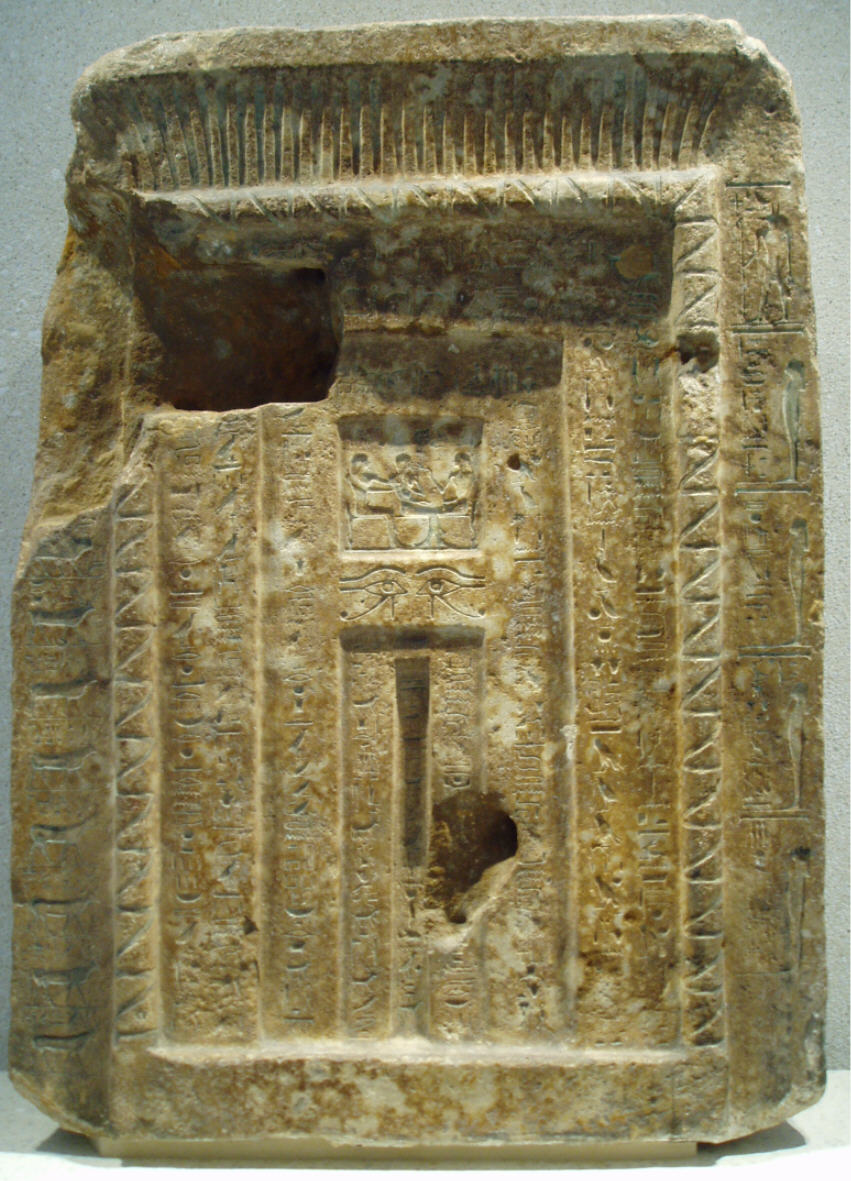
One of the most important finds in TT71 is the false-door stele illustrated above (today Berlin, object 2066; Photo:
L.Franke, 2010) and the coffin of Senenmut.
The expedition headed by Lepsius discovered the false-door stele lying
at the end of the corridor (at the western wall). Based on the location
of its discovery it is assumed that its original position was directly below the niche,
where both had built the funeral focus of the tomb. It consists of a only one yellow quartzite block, whose front
builds a false door. Already in the antiquity the stone block possessed
some defects, the smaller ones with filled with mortar, the large ones
at the left corner of the block were filled with two blocks of masonry - which are missing today -
which were set in mortar.
|
|
The decoration shows the facade of a chapel with a torus molding and and
crowned by a cavetto cornice. Several jambs form a false-door in the center
which rests on a rectangular base. Above the false-door a funeral banquet
scene shows Senenmut and his parents. The stele is inscribed with portions
of Chapter 148 of the Book of Dead. On either side it is decorated with
deities associated with this text: on the right exterior Anubis (top of
the row) and the four mummy-like rudders of heaven, on the left exterior
the bull and the 7 cows of the sun God. This message from the dead book is to protect the deceased in beyond before each possible damage and protect its food supply.
|
|
Above the door fall two Udjat-eyes (wDAt)
are shown. Senenmut himself is represented in in the center of a funeral
banquet scene - above the two wDAt-eyes.
The scene is completed by his father who is sitting on the left side
behind him and his mother who is sitting opposite to him. His father is
shown putting his arm around the shoulder of Senenmut, and his mother holds a
lotus flower to his nose. No offerings are shown.
|
|
This false-door stele of the Senenmut is in several respects remarkable:
|
1. the used stone - quartzite - was exclusively reserved for the king (e.g. for
sarcophagus) - private individuals were allowed to use only different types of rock, e.g. granite.
2. nevertheless, Senenmut uses quartzite for a part of his tomb, which
was accessible to the public - thus by no means hidden.
3. the false-door stele show some remainders of a blue/green painting (in the photo to unfortunately hardly
to detect - a little still on the right, inside the figures of the Anubis and the
mummiform rudders). However, a blue/green color was normally never used
to paint quartzite (if necessary a yellow color was taken to paint quartzite
), but it was used for granite.
|
|
This leads directly to the conclusion that this stele does not only imitate a
false-door, but - by painting - it also imitated granite, a type of stone Senenmut
was allowed to use at best .
|
| From his tombs the following funerary cones have survived. |
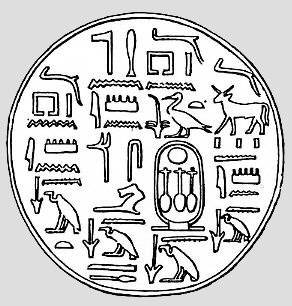 |
|
Inscription (Zenihiro, 2009):
jmj-rA pr n jmn sn-n-mwt
Hm-nTr n jmn wsr-HAt sn-n-mwt
mAa-xrw
jmj-rA pr n sAt-nswt nfrw-ra sn-n-mwt
jmj-rA
jHw n jmn sn-n-mwt
Steward of Amun, Senenmut,
prophet of the (barque) 'Userhat-Amun', Senenmut justified,
steward of the king's daughter, Neferure, Senenmut,
overseer of the cattle of Amun, Senenmut.
|
Funerary cone of Senenmut attributed to TT71
(see: Dorman 1991); Macadam No. 84;
Ø ? cm
Metropolitan Museum of Art, New York |
|
|
|
|
|
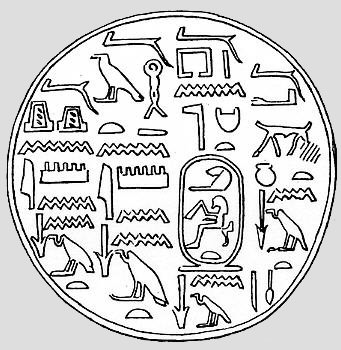 |
|
Inscription (Zenihiro, 2009):
jmj-rA Snwtj n jmn sn-n-mwt
jmj-rA AHt n jmn sn-n-mwt
jmj-rA pr n Hmt-nTr HAt-Spst sn-n-mwt
jmj-rA aXnwtj sn-n-mwt mAa-xrw
Overseer of the double granary of Amun, Senenmut,
overseer of the fields of Amun, Senenmut,
steward of the god's
wife Hatshepsut, Senenmut,
chamberlain, Senenmut justified
|
Funerary cone of Senenmut attributed to TT71
(see: Dorman, 1991); Macadam Nr. 88;
Ø ? cm |
|
|
|
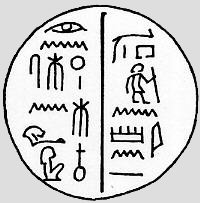 |
|
Inscription (Zenihiro, 2009):
jmj-rA pr wr jmn jrj.n ra-ms ms.n
HAt-nfr
Chief steward of Amun, born by Ramose, born by Hat-nefer |
Funerary cone of Senenmut (TT71 or 353); Macadam Nr. 261;
Ø ? cm |
|
|
|
